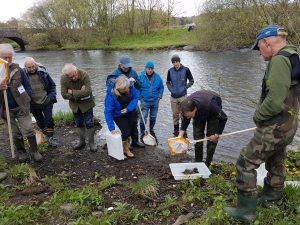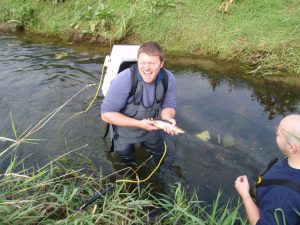Our Riverfly and Electrofishing Monitoring in 2020
20 January, 2021
by Rachael Halhead
Riverfly report
SCRT have a Riverfly monitoring programme in which volunteers get involved to survey and protect the health of the local rivers and becks in South Cumbria. This initiative provides a simple monitoring technique which we can use to detect any severe perturbations in river water quality.  That’s because the common characteristics of riverfly; their limited mobility, relatively long life cycle, presence throughout the year and specific tolerances to changes in environmental conditions make them powerful biological indicators to monitor water quality.
That’s because the common characteristics of riverfly; their limited mobility, relatively long life cycle, presence throughout the year and specific tolerances to changes in environmental conditions make them powerful biological indicators to monitor water quality.
Our volunteer programmes took a hit in 2020 but why not take a look at what our volunteers did manage to get out and do. Take a look at our 2020 Riverfly report here
Electrofishing report
Electrofishing is a monitoring technique used to assess the health, abundance and density of juvenile salmonid (salmon and trout) populations. It also helps to gather basic habitat information, is an important engagement tool for those interested in learning more about their local becks and allows us understand trends over time. Salmonids are also key indicators of freshwater health and general catchment functioning.
 It uses electricity to temporarily stun fish which are drawn to the electrode before being scooped up into a net and into a bucket by the side of the water. We then assess them and return them to the river. When done correctly, Electrofishing results in no permanent harm to fish which return to their natural state as soon as the electrode is switched off. Our trained staff conduct a large number of sessions during June to September every year with volunteers, interested in learning about this technique.
It uses electricity to temporarily stun fish which are drawn to the electrode before being scooped up into a net and into a bucket by the side of the water. We then assess them and return them to the river. When done correctly, Electrofishing results in no permanent harm to fish which return to their natural state as soon as the electrode is switched off. Our trained staff conduct a large number of sessions during June to September every year with volunteers, interested in learning about this technique.
Why not take a look at the 2020 results here
A big thank you to our committed volunteers, without who this monitoring programme would not survive.
 That’s because the common characteristics of riverfly; their limited mobility, relatively long life cycle, presence throughout the year and specific tolerances to changes in environmental conditions make them powerful biological indicators to monitor water quality.
That’s because the common characteristics of riverfly; their limited mobility, relatively long life cycle, presence throughout the year and specific tolerances to changes in environmental conditions make them powerful biological indicators to monitor water quality. It uses electricity to temporarily stun fish which are drawn to the electrode before being scooped up into a net and into a bucket by the side of the water. We then assess them and return them to the river. When done correctly, Electrofishing results in no permanent harm to fish which return to their natural state as soon as the electrode is switched off. Our trained staff conduct a large number of sessions during June to September every year with volunteers, interested in learning about this technique.
It uses electricity to temporarily stun fish which are drawn to the electrode before being scooped up into a net and into a bucket by the side of the water. We then assess them and return them to the river. When done correctly, Electrofishing results in no permanent harm to fish which return to their natural state as soon as the electrode is switched off. Our trained staff conduct a large number of sessions during June to September every year with volunteers, interested in learning about this technique.